I admit, I was initially a bit apprehensive about the concept of being totally isolated for eight days in the Arctic wilderness, 63 miles north of the Arctic Circle. Would I panic without reliable cell phone connectivity or Wi-Fi, far away from my busy life in bustling Los Angeles and the security of my loved ones? In April, I put these anxieties to the test. Instead of traveling somewhere more “traditionally” associated with a yoga certification like India or Bali, I felt called to embark on a more adventurous (albeit remote) trip to learn amongst the wild and inspiring beauty of Northern Alaska.
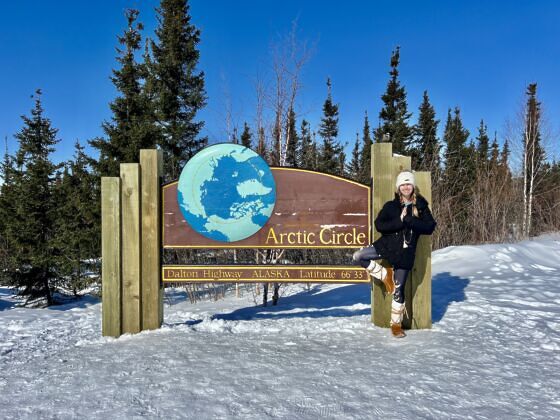

My Yoga Teacher Training Happened 63 Miles North of the Arctic Circle. Here’s How It Changed Me.
The “SHEWild” women-only 200-hour Yoga Teacher Training, led by Mollie Busby of the Arctic Hive, took place in the tiny but mighty village of Wiseman, Alaska, the “immersive” portion of my hybrid training experience to earn yoga teacher certification. It’s no coincidence how powerful and transformative the journey felt in the heart of Northern Alaska. The retreat forever changed my yoga practice and, I’m learning after the experience, has had the same positive experience in other aspects of my life.
A hybrid training experience opens opportunities from afar
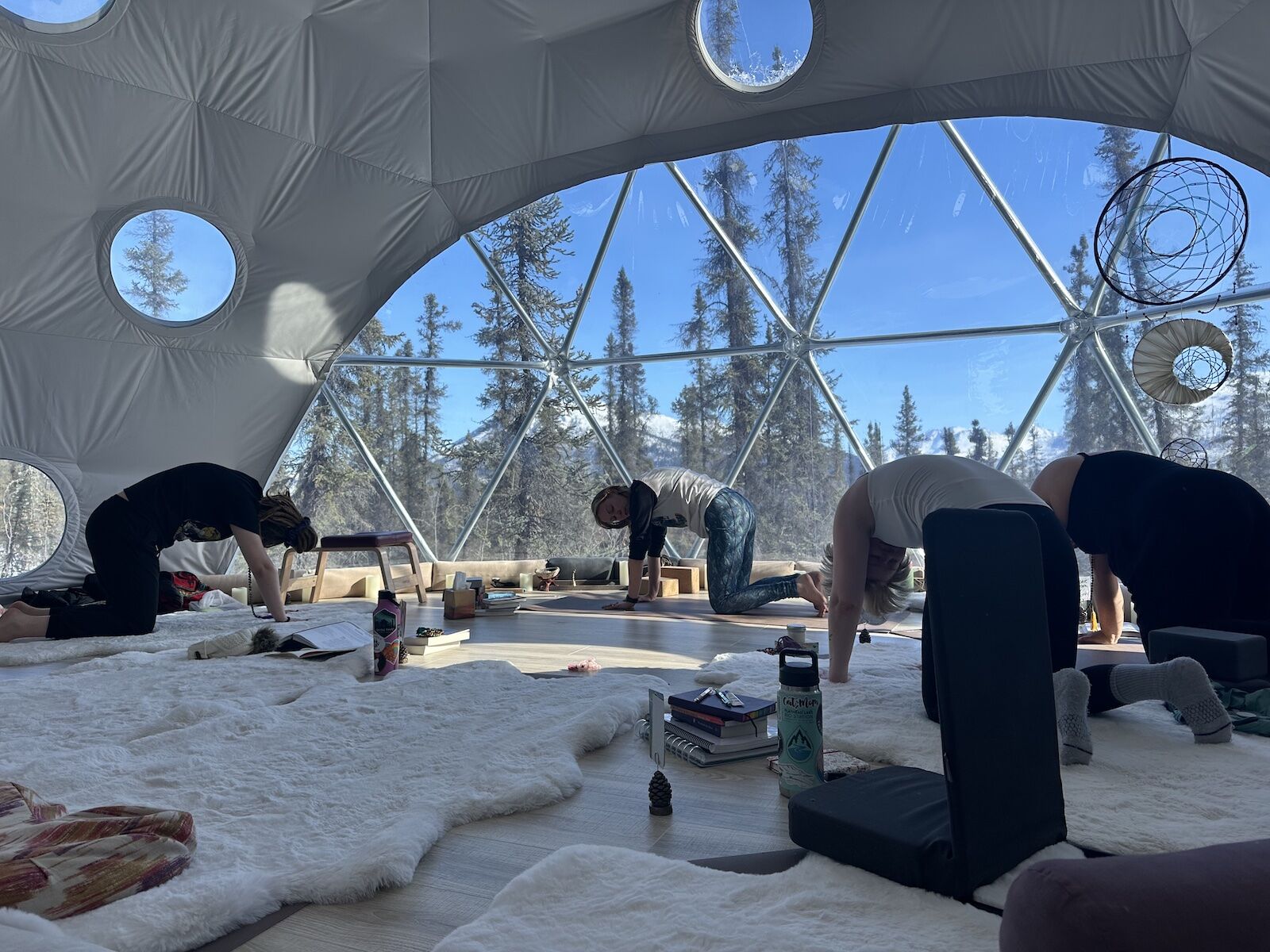
The author leading class. Photo: Mollie Busby
It’s important to recognize there was no such thing as a “hybrid” yoga teacher training before the COVID-19 pandemic expanded online learning and made virtual certifications a possibility. Yoga Alliance, the largest nonprofit association representing the yoga community and arguably the most trusted regulator of Yoga Teacher Training certification regulation, didn’t allow online or hybrid training or certification pre-covid.
The pandemic rocked everyone’s world, but one thing that came out of such a challenging situation was expanded opportunities to learn and grow online, virtually, and build digital communities as opposed to solely being able to earn degrees and certifications in person. As academic universities worldwide loosened their criteria to allow students to earn their degrees digitally, so did the Yoga Alliance.
For me, that meant a chance to build a community and earn my certification alongside seven other women ranging in geographic location from Alaska to Maryland, San Diego, Wisconsin, and, in theory, anywhere in between.
For my yoga teacher training experience, our education was segmented into three parts.
Part one of our training included a live online instruction series, where we logged onto Zoom for two weekend-long sessions spanning from roughly 4 PM to 7 PM Pacific Time on Friday and 6:30 AM to 2 PM Pacific Time on Saturday and Sunday. We also had four weekday virtual meetings of live online instruction in between these weekend sessions. On the final Zoom session, we’d be teaching a 45-minute class to our fellow trainees — a task that initially seemed daunting but, like the trip to Alaska, became an incredibly positive and transformative experience for our cohort.
Part two of the training meant keeping up with pre-recorded, self-paced video content produced exclusively for the “SHEWild” cohort. We’d work through this “homework” material progressively on our own time.
But the part of the experience that called to me most was part three: an immersion trip to Mollie Busby and her husband Sean’s property, Arctic Hive, in Wiseman, Alaska.
The Arctic Hive cultivates a magical sense of community in the backcountry
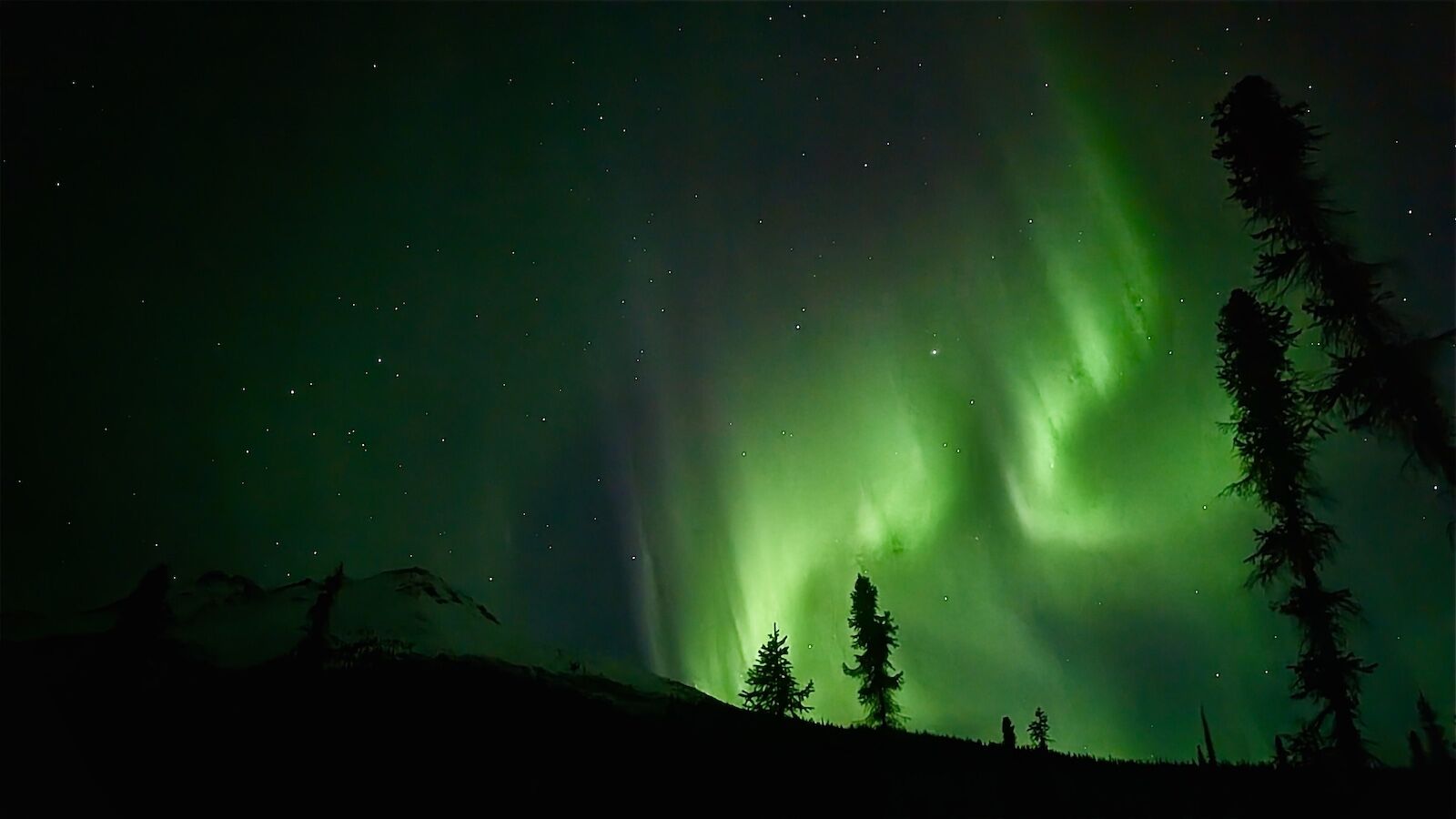
The Northern Lights made frequent apperances. Photo: Molly O’Brien
This retreat is located 270 miles from the nearest town (seven hours from the nearest grocery store) — among the breathtaking scenery of the arctic Brooks Range. It’s known as the northernmost yoga school in America.
Arctic Hive is located between two well-known protected wilderness areas of the Brooks Range (Gates of the Arctic National Park and Arctic National Wildlife Refuge), meaning pure and unfiltered wilderness. Spending time here meant experiencing a raw, introspective journey that’s a bit more far-flung — and far less humid than some other teacher training trips I had heard of.
At Arctic Hive, travelers are separated from the petty problems of the outside world and have the space to become more aware of what’s really important — feeling and fostering a genuine connection between two souls (whether it’s human to human or animal to human), loving and kindness, and respect for our bodies (they’re the only ones we get).
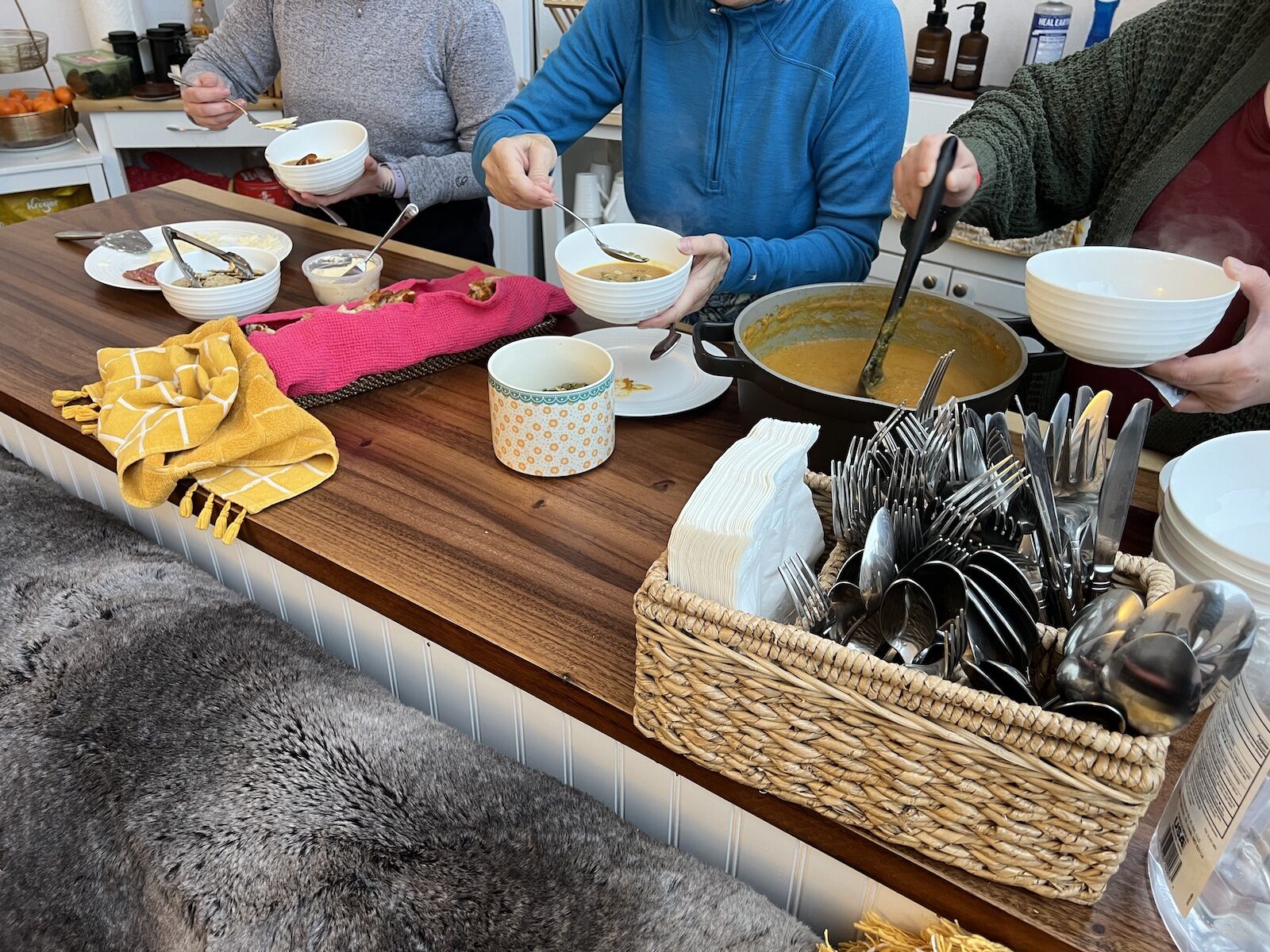
Dinner is served. Photo: Molly O’Brien
It’s a total physical and neurological reset for those who take the time to invest in the experience. We nourished ourselves with healthy food eaten in a community setting and learned away from the anxieties that can come with access to modern technology.
But actually getting to the Arctic hive isn’t an easy feat. The journey to this remarkable destination requires quite a physical and financial investment. Travelers fly to Fairbanks where they’ll meet up with the cohort of fellow trainees for an 8-10 hour drive along the daunting Dalton Highway up to the 12-person village of Wiseman, a century-old former mining town, which boomed in the 1920s but today serves mostly as a seasonal destination for viewing the aurora borealis and as a home base for outdoor recreation. From Wiseman, it’s a short one-mile hike upslope to the property, which labels itself “boutique, off-grid accommodations” and is settled into the bush on a hill overlooking the town.
Life at The Hive
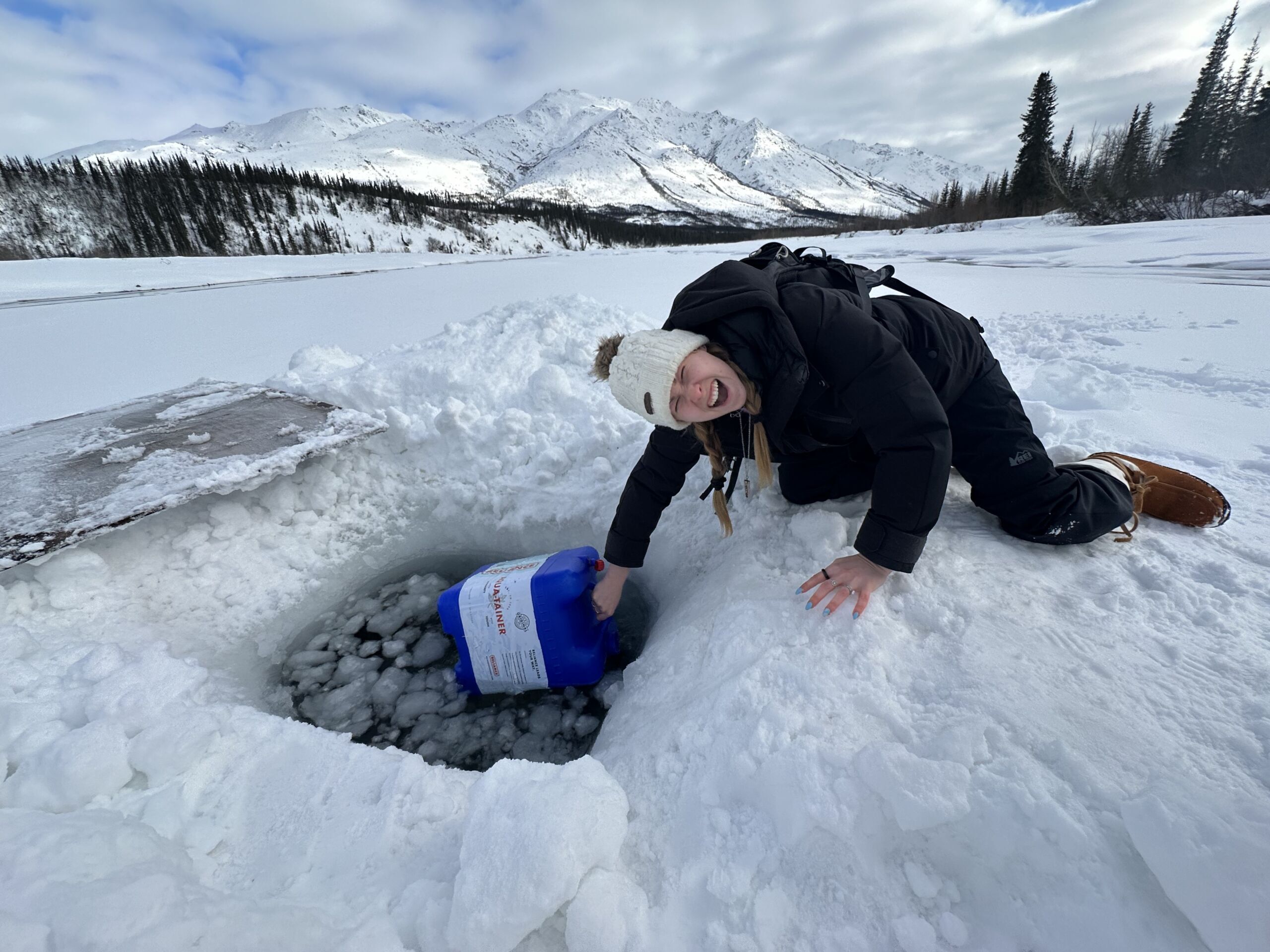
The author fetching water before getting soaked. Photo: Mollie Busby
The cost of my immersion trip and training, totaling $4,950, included transportation to and from Fairbanks, lodging, my yoga teacher training manual, and three home-cooked square meals a day on-site.
Once we arrived at Arctic Hive, we cozied into our assigned cabins — three off-grid Nordic-style buildings perched at the top of the hill overlooking the property, each boasting stunning mountain views.
The big windows showcase the snowy peaks during the day and the colors of the aurora borealis on a clear night. There was ample heating via Swedish Nordic oil stoves, solar and battery-powered lighting, a Berkey water filter system for fresh drinking water (sourced by Arctic Hive), and old-fashioned kerosene lamps. Power on-site is soured via solar, with a backup generator. All cooking needs are met by propane).
But the real kicker (and something we knew going into this trip — but which hadn’t set in until we left Fairbanks and were clear out of cell phone range) was minimal-to-no real connection to the outside world.
Guests are allowed to use the cell phone booster that Mollie and Sean have if they need to connect with a loved one or require some sort of communication accommodation — but in reality, there was virtually no reliable cell phone or computer connectivity (and no need for it) for the duration of the entire trip.
It didn’t matter. It felt comforting to know we were safely isolated from the dangers and discomforts of the outside world inside the cocoon that is Arctic Hive. We spent a lot of time in the property’s Wilderness Lodge — a 20-foot diameter insulated fiberglass igloo dome that the couple built themselves, by hand. In fact, everything on this property was built by Mollie and Sean (there was nothing here upon their arrival to the land) via lumber and supplies hauled in during the warmer months, the only time of year when construction is possible. This dome was where we gathered for meals and bonding between lectures and lessons.

The dome at dusk. Photo: Mollie Busby
Down the hill a bit further is the destination that attracts the eye of most attendees before their trip even begins — a 24-foot Geodesic dome called the “Yoga Hive,” or “The Hive” for short. This is the first place we’d meet upon waking, where we’d practice daily, and where most of our lessons and lectures were held during the immersion.
To say the Yoga Hive is “dreamy” would be an understatement.
This enormous, clear fiberglass dome offers sights of the snow and scenery from above, seemingly bringing you at one with Earth and sky in a protected space meant for releasing all tensions while soaking up the serene spirits. It was like a warm cocoon away from the harsh realities of the real world. Some people travel to Arctic Hive because they see photos and are drawn in by the serenity of the Yoga Dome, and its easy to understand why.
Another favorite part of the journey for me (and my fellow women trainees) was the Busby’s sled dogs, which slept on-site right next to the Yoga Hive igloo in the dog yard.
These jovial, energetic pups were born and bred for pulling sleds — but are Mollie and Sean’s pets, whom they care for and love. Each has its own dog house embedded with a thick layer of straw. While we were at Arctic Hive for our retreat, we were lucky enough to go on a dog sledding ride, an invigorating change of pace.
As for bathroom breaks? It’s still the backcountry wilderness, after all — meaning visitors do their “business “ in the single clean outhouse that’s tended to daily (along with a few designated “facility trees” in the woods).
Interconnectedness in the wilderness
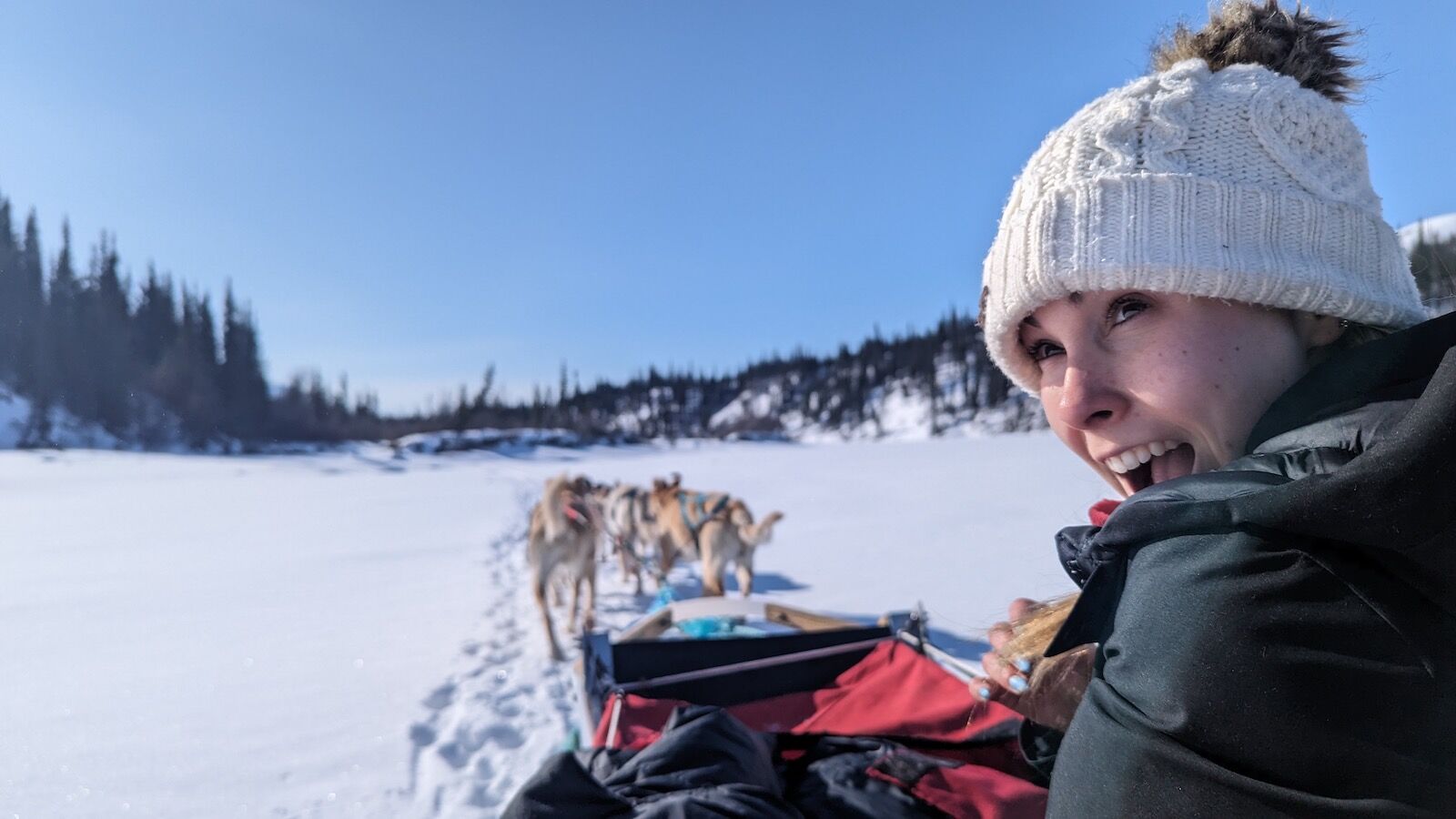
The excitement level matched the beauty of our surroundings. Photo: Tamara Swenson
Living this way — essentially off-grid, among other like-minded women from across the country who had all come to this magical place to learn about spirituality in a completely immersive sense — made yoga teacher training even more powerful than I’d thought possible.
For those who want to visit and experience the enchanting setting of Arctic Hive but aren’t necessarily interested in investing in getting their yoga teacher certification, Mollie and Sean host a lineup of other organized retreats throughout the year. They also rent out the space to groups who want to host customized retreats.
This adventurous duo knows exactly what they’re doing, incorporating respect for their surroundings and a commitment to preserving the integrity of the sacred land on which they reside.
Adventures in the Arctic
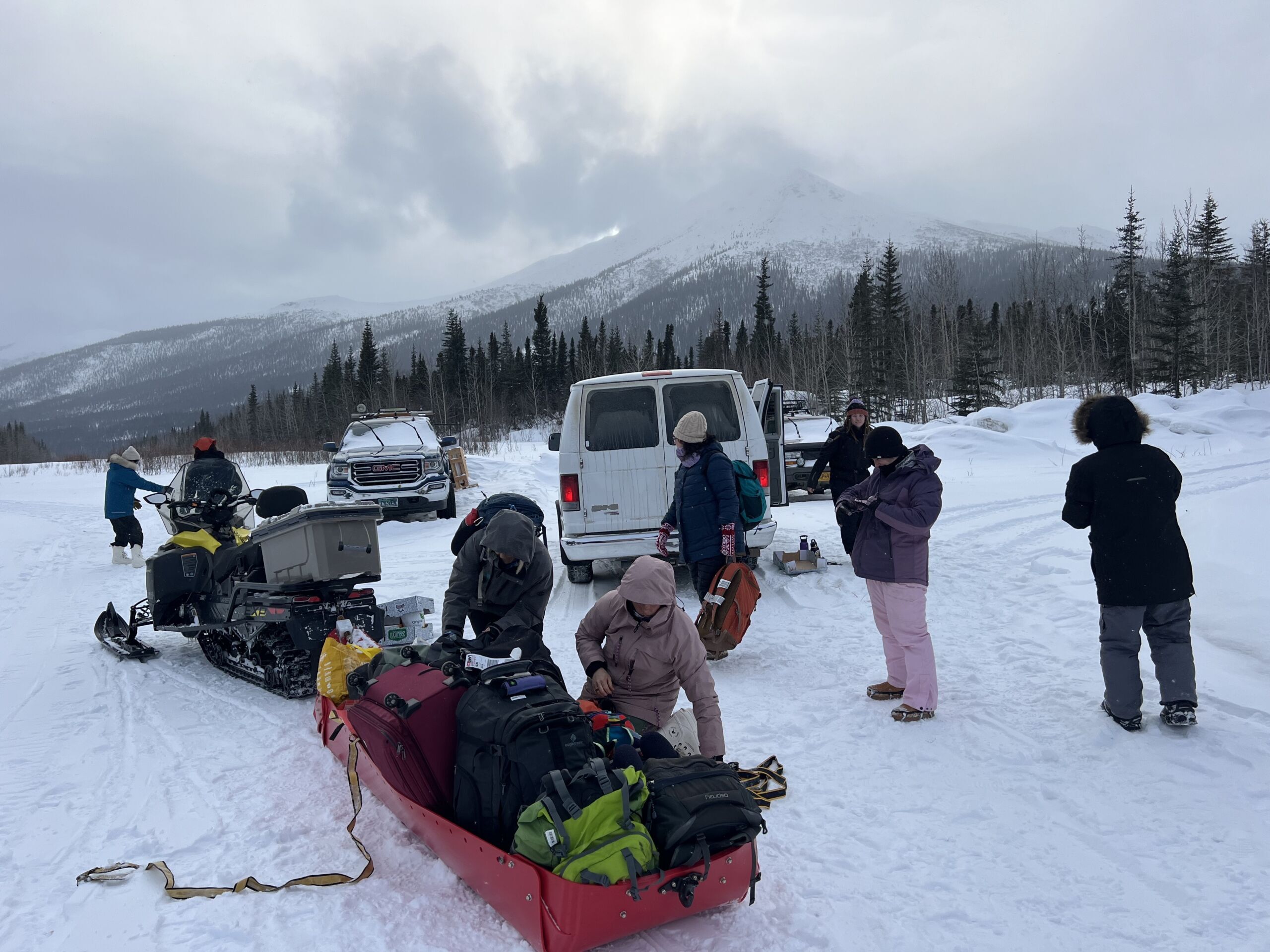
Baggage claim in the Arctic. Photo: Molly O’Brien
Mollie and Sean’s sled dogs taught us that in this wild place, Mother Nature is the ultimate Queen. After one particularly rowdy and howl-y night on the date of the 2024 solar eclipse (these dogs like to howl — but there was more howling than usual on this evening) we discovered one of the dogs had given birth to a puppy. It was thrilling, unexpected, and very much welcomed.
The new pup, appropriately named “Eclipse,” made us more aware of how powerful and self-sufficient nature is (we had no idea this dog was pregnant, and it gave birth using its existing instincts and no human intervention). I had never seen a creature so tiny, but fierce. This pup was born in the bush and its mother knew how to survive and keep it alive without anyone else even being aware of its existence until the next morning during the dog’s breakfast time.
I, however, learned how harsh and unforgiving the tundra can be (especially mixed with climate change appearing to warm the earth quicker and quicker each year). One afternoon, I went with Mollie and a few other women to source water that would be filtered for us to drink and cook with. We went down to the river that the Busbys use for their freshwater filtration efforts and dragged the sled across the “ice bridge” leading to the river.
Someone made a joke about falling into the river, and we each leaned over the ice one at a time and filled the bucket up with the streaming snowmelt water, which was frigidly cold, then turned to head back to the Hive with our haul on the sled. I was about 10 steps behind Mollie and another trainee, when I stopped to admire the view of the mountains behind the river from on top of the ice bridge (and perhaps try to snap a quick photo of the sights).
Like something out of a movie, everything sped up while I felt myself tilting downward — slowly, at first, then more quickly careening forward toward and then into the river. Before I even realized what happened I was engulfed from the hip down on my right side in the freezing water — and after we all realized I was physically we were in fits of laughter, because what are the odds it’d actually happen? I became the girl that fell into the frozen river and I don’t think I’ll ever live it down (oh well). Fortunately I was just in need of some dry clothes and a boot warmer to dry out my Mukluks.
No cell phones (just sisterhood) — no problem

The inside of a cabin at Arctic Hive. Photo: Molly O’Brien
After a week of waking up each morning to the quiet and crispness of the clear Arctic air followed by a morning meditation and a series of educational lectures, hikes, and yummy, healthy meals, it was as if we had been spiritually healed (or were on our way to healing ourselves based on the lessons we’d learned in this sacred safe space. It was then time to come out of the cocoon and leave the hive, to return to the “real world” and reintegrate ourselves into society, but with a newfound sense of wonder and purpose.
Witnessing the power of bringing new life into the world with the birth of an innocent puppy, paired with the harsh reality of a river submerging incident (that in another, colder season could have led to vastly more dire consequences), melded with the general sense of community and support felt between the women on-site at Arctic Hive inspired a fresh sense of hope and wonder for healing ourselves and others.
Forever changed inside, among the same outside reality
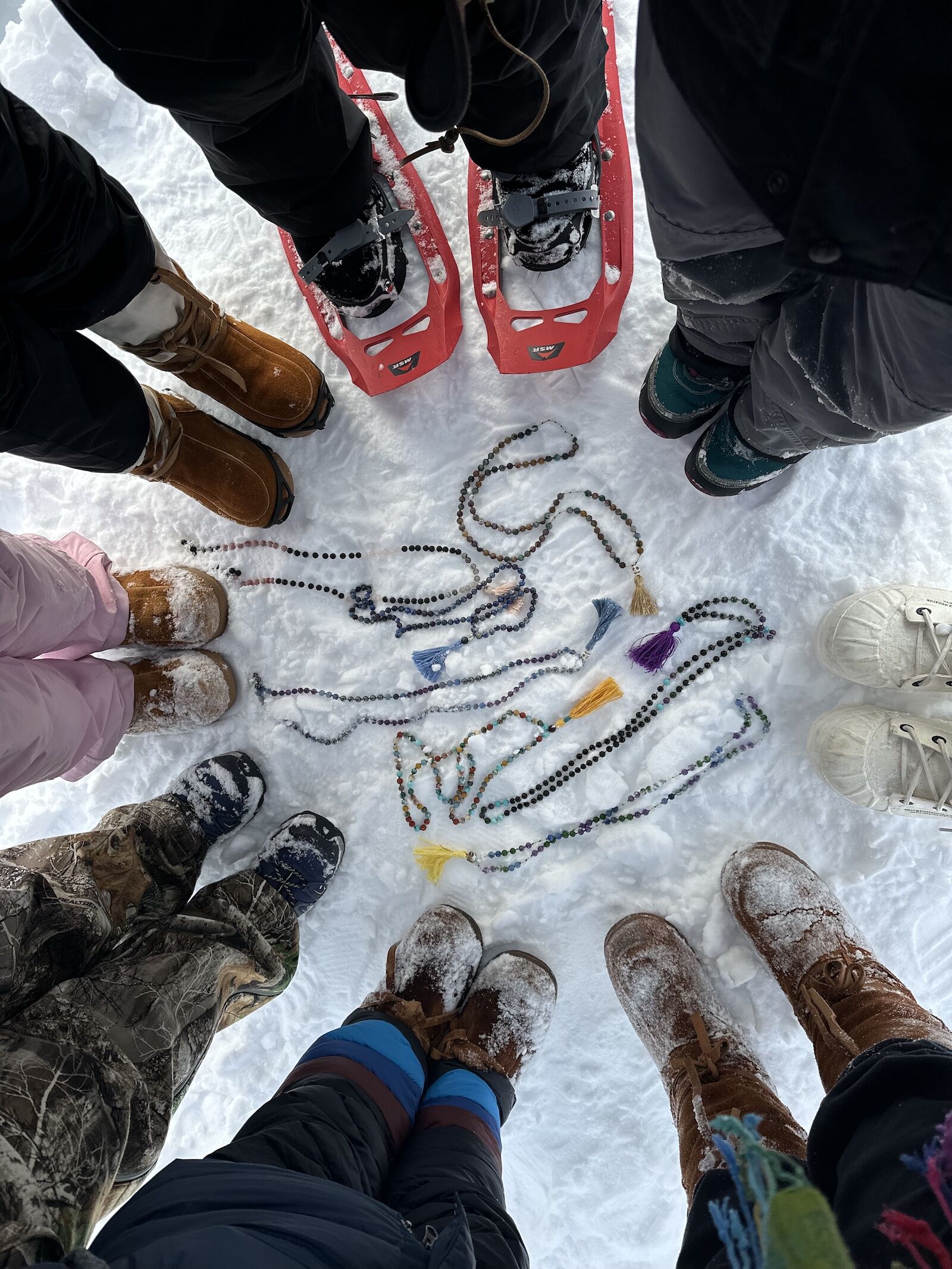
Having a mala moment. Photo: Mollie Busby
Luckily for us, once we reintegrated following our trip to the Arctic, the journey wasn’t over. We still had a month of virtual teacher training lessons to conquer and a final weekend-long Zoom session where we’d draw together everything we’d learned by each solo teaching a 45-minute class.
During the final day of class, we came together to reflect on how much the experience had changed our lives — from the heartfelt connections we’d made virtually, to the power of the immersion experience and how it stripped us down to reinforce how the most important things in life are not necessarily tangible.
The lessons we learned at The Hive were both in yogic tradition and human nature — to care for and be open to being taken care of, letting go of outside fears and inhibitions and instead opening ourselves up to possibilities that can come with a clearer sense of self-purpose and a greater intention for cultivating a better world.
Traveling to Arctic Hive is an investment spiritually and physically and I can now say with full confidence once you go, your perception of reality will forever be enlightened.